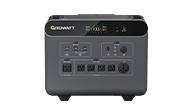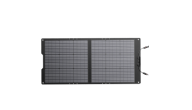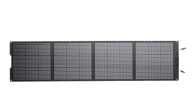A solar powered greenhouse harnesses the sun's energy to provide heating, cooling, lighting, and power for a greenhouse's operations and cultivation. There are a few main ways a greenhouse can utilize solar power:
-
Passive solar design - Orienting the greenhouse and using glazing materials to naturally maximize heat gain in winter and minimize heat gain in summer. This uses free solar energy for heating and cooling.
-
Solar panels - Photovoltaic solar panels convert sunlight into electricity that can power fans, pumps, lights, and other electrical equipment in the greenhouse.
-
Solar generator - A solar generator consists of solar panels that charge batteries, which then provide backup power storage. This allows using solar electricity day and night.
The goal of a solar powered greenhouse is to reduce reliance on grid electricity and fossil fuels while leveraging renewable solar energy as much as possible. Solar energy can provide a free, clean resource to create an optimal growing environment in the greenhouse. Careful design is needed to properly size the solar power system and maximize the benefits.
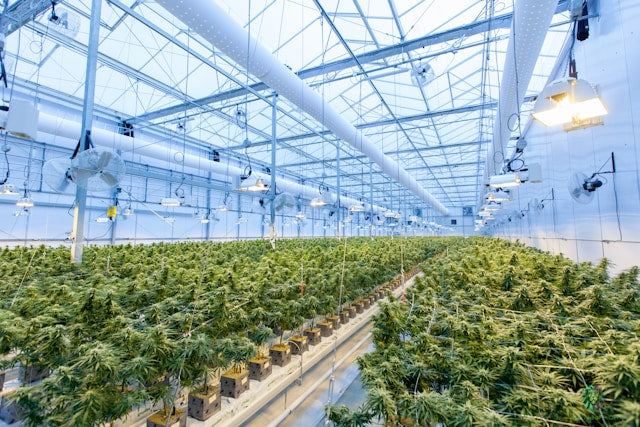
How Solar Greenhouses Work
Solar greenhouses harness the sun's energy to heat and light the growing space. They utilize passive solar design principles to maximize heat gain in winter and minimize overheating in summer.
Key factors in passive solar greenhouse design include:
Orientation
Orienting the greenhouse to face as close to due south as possible maximizes sunlight exposure. This allows the greenhouse to capture solar energy throughout the day. Situating the glazing primarily on the south side helps collect solar radiation during winter.
Glazing Materials
Glazing materials like glass or polycarbonate panels allow sunlight into the greenhouse while reducing heat loss. Using double or triple glazing enhances the greenhouse effect. Movable insulation can be added to glazing at night or during cold seasons to retain heat.
Thermal Mass
Materials with high thermal mass like stone, concrete and water barrels absorb sunlight's energy during the day and slowly release heat at night. Locating thermal mass along the back wall helps trap warmth. The thermal mass stabilizes temperatures and reduces day/night temperature swings.
Insulation
Insulating the north wall, sides and foundation prevents heat loss. Insulation keeps the absorbed solar energy inside the greenhouse. Closed cell foam, rigid foam boards, and straw bales are effective insulators for solar greenhouses. Proper insulation drastically reduces heating requirements.
By incorporating these passive solar design features, solar greenhouses can stay warm and productive even during cold weather with minimal need for additional heating. The combination of glazing, insulation and thermal mass work together to capture, retain and distribute solar energy.
Comparing Solar Greenhouse Options
When it comes to powering a greenhouse with solar energy, there are three main options to consider: passive solar greenhouses, solar panels, and solar generators. Each has its own pros and cons.
| Aspect | Passive Solar Greenhouses | Solar Panels | Solar Generators |
|---|---|---|---|
| Cost | Low | Moderate to High | Moderate to High |
| Electrical Components Needed | None | Solar panels, inverters, batteries | Solar panels, batteries, inverter |
| Dependence on Sunlight | High | Moderate to High | High |
| Control over Environment | Limited | High | Limited |
| Reliability During Outages | High | Depends on battery backup | High (if battery backup included) |
| Maintenance | Low | Moderate | Moderate |
| Installation Complexity | Low | Moderate to High | Low to Moderate |
| Energy Storage | None | Depends on battery backup | Yes (battery storage) |
| Portability | Not applicable | Not applicable | High |
| Suitable for Off-grid Use | Limited | Yes | Yes |
Passive Solar Greenhouses
Passive solar greenhouses utilize solar energy directly without any electrical components. The greenhouse structure and materials are designed to maximize heat gain in winter and minimize it in summer.
Pros:
- Very cost effective. No electrical components needed.
- Can still function during power outages.
- Lower maintenance than active solar systems.
Cons:
- Limited control over interior temperature and humidity.
- Need proper greenhouse orientation and glazing materials.
- Provides no electricity, only heat.
Solar Panels
Solar panels (aka photovoltaic panels) can be installed on a greenhouse roof to convert sunlight into electricity. The electricity can then power fans, lights, heaters, and other devices.
Pros:
- Generate electricity to power electric appliances and devices.
- Can power a greenhouse year-round, even without sunlight.
- More control over greenhouse environment.
Cons:
- Higher upfront investment than passive solar.
- Dependent on full sun exposure.
- May still need batteries to store surplus solar electricity.
Solar Generators
Portable solar generators consist of solar panels, charge controller, inverter, and batteries in one unit. They can provide solar electricity without installing solar panels on site.
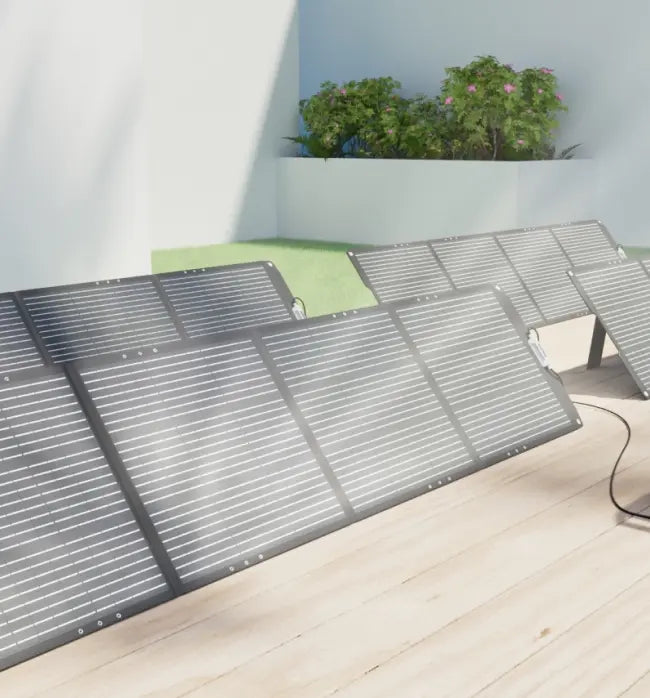
Pros:
- Fully self-contained, portable units. No installation required.
- Can power a greenhouse off-grid or during power outages.
- Store solar energy in batteries for on-demand use.
Cons:
- Higher cost than solar panels.
- Limited capacity compared to permanent solar panel systems.
- Need space to place unit near greenhouse.
Solar Greenhouse Power Needs
When considering solar power for a greenhouse, it's important to understand how much electricity the structure will require. The main power draws in a greenhouse are lighting, ventilation and heating systems.
Lighting
Most greenhouses rely on supplemental lighting, especially in winter or cloudy conditions when natural sunlight is insufficient. Typical wattages for greenhouse lighting include:
- LED grow lights - 50-200 watts per fixture
- High pressure sodium lights - 400-1000 watts per fixture
- Fluorescent tubes - 25-55 watts per tube
The amount of lighting needed depends on the greenhouse size and what is being grown. Leafy greens and herbs may need only 50-100 watts per square foot. Fruiting plants like tomatoes may require up to 200 watts per square foot for adequate growth and fruit production.
Ventilation
Greenhouses need good air circulation and ventilation systems. Exhaust fans are used to bring in fresh air and remove hot, humid air. Circulating fans improve air movement around plants. Ventilation power needs include:
- Exhaust fans - range from 50 watts for small greenhouses up to 500+ watts for large commercial structures.
- Circulation fans - typically draw 60-100 watts each.
Proper ventilation prevents problems like mold growth and helps maintain appropriate temperatures.
Heating
Supplemental heat is necessary to maintain appropriate greenhouse temperatures in colder weather. Heating systems produce the biggest power demand:
- Electric heaters - can draw 1000-4000 watts or more
- Electric boiler systems - often pull 2000-5000+ watts
The heating requirements vary drastically depending on climate, greenhouse insulation, desired temperatures and season extension goals. Heating needs are highest at night and during winter.
When totaling the typical wattages for lighting, ventilation and heating, most hobby greenhouses will need 1000-3000+ watts. Larger or highly illuminated commercial operations may require 5000-15000+ watts. Understanding the estimated electrical loads is key for properly sizing a solar power system.
Sizing a Solar Power System
To properly size a solar power system for a greenhouse, you'll need to calculate the energy consumption of your greenhouse equipment. Here are the key factors to consider:
Calculate Electrical Load
-
Take an inventory of all electrical devices in the greenhouse, including lights, fans, heaters, pumps, and appliances. Note the wattage of each.
-
Estimate the number of hours per day each device is likely to run. Multiply the wattage by the estimated hours of use per day to get the daily watt-hours (Wh) for each device.
-
Add up the watt-hours for all devices to get the total daily energy consumption, or load, for the greenhouse.
Determine Peak Power
-
The peak power is the maximum power draw from all devices running at once.
-
Add up the wattages of all devices that could potentially run simultaneously. This is the peak power that the solar system must be able to provide.
Calculate Solar Array Size
-
Using the total daily energy consumption in watt-hours, choose a solar panel size that can generate that amount of energy per day.
-
Factor in your geographic location and average daily sunlight hours. More sunlight means smaller panels can meet the same energy needs.
-
For a solar generator system, select a model that can provide the needed peak power output calculated above. Choose a battery capacity that meets the total daily energy consumption.
Properly sizing your solar power system will ensure it can efficiently and reliably meet the electricity needs of your greenhouse. Consult with a solar installer for help with calculations and equipment selection.

Passive Solar Greenhouses
Passive solar greenhouses rely on design features to capture and store solar energy for heating the greenhouse, without needing electrical or mechanical equipment. Key elements of passive solar greenhouse design include:
Glazing Materials
Glazing refers to the transparent or translucent materials on the roof and walls that let sunlight into the greenhouse. Common glazing materials are glass and rigid plastic panels like polycarbonate or acrylic. The glazing should have high solar transmittance to maximize solar gain. Using double or triple layers of glazing with air spaces in between provides better insulation and reduces heat loss. Movable insulation can be added to trap heat at night.
Insulation
Providing proper insulation is crucial for passive solar greenhouses. The walls, foundation perimeter, and subsoil should all have adequate insulation to reduce conductive heat losses. The insulation also helps store absorbed solar energy in the mass of the structure. Common insulation materials are rigid foam boards, closed cell spray foam, and fiberglass batts.
Thermal Mass
Thermal mass in the form of masonry materials (brick, concrete, stone) or containers of water absorb and slowly release heat in the greenhouse. The thermal mass soaks up excess heat during the day and radiates it back out at night to prevent drastic temperature swings. Trombe walls are a common thermal mass system made of thick concrete, masonry or water tanks.
Ventilation
Ventilation allows heated air to escape and cooler air to enter for temperature regulation. Passive ventilation uses vents on opposite walls/ends of the greenhouse that open and close automatically via thermostats or wax actuators. Roof vents and fans provide additional airflow. Proper ventilation prevents overheating on sunny days.
Solar Panels for Greenhouses
Solar panels, also known as photovoltaic (PV) panels, can be an effective way to power a greenhouse. Here are some key considerations when using solar panels:
Typical System Size
The size of the solar panel system depends on the power needs and location of the greenhouse. A small hobby greenhouse may only need a few 100-watt panels, while a large commercial greenhouse could have an array of multiple 250+ watt panels. Panels are measured in watts, and it takes about 10 square feet of solar panels to produce 1000 watts.
Wiring
Solar panels produce DC power, so an inverter is needed to convert to standard AC power. The panels are wired into solar charge controllers that regulate the voltage and connect to batteries to store power. The batteries then connect to the inverter and the greenhouse electrical system.
Installation
Solar panels can be roof mounted or ground mounted near the greenhouse. The panels should face true south if in the northern hemisphere or true north if in the southern hemisphere. Roof mounting is easier but can require roof reinforcement. Ground mounting allows tilting the panels for optimal angle.
Solar Generators for Greenhouses
Solar generators harness the power of the sun to keep greenhouse equipment running, even when the grid goes down. They consist of solar panels, batteries, and an inverter.
The solar panels charge the batteries during daylight hours. The batteries store the energy for use at night or on cloudy days when the solar panels aren't producing power. The inverter converts the DC power stored in the batteries into AC power that most greenhouse equipment requires.
Battery Capacity
Solar generators for greenhouses typically need large battery banks to store enough energy to operate lights, fans, heaters, and other equipment when the sun isn't shining. Lithium-ion batteries offer the best combination of high capacity and performance.
Greenhouse solar generator batteries are sized according to the greenhouse's average daily energy use. For a small hobby greenhouse, batteries with 1-2 kWh capacity may suffice. Larger commercial greenhouses will need 10 kWh or more of battery storage.
Inverter Sizing
The inverter in a greenhouse solar generator converts DC battery power into AC power. Inverter sizing depends on the greenhouse's peak power demands.
For a greenhouse with basic LED lighting and fans, a small 1,000W inverter may be adequate. If running power-hungry heaters or other equipment, a 3,000W or larger inverter is recommended. Oversizing the inverter ensures all the greenhouse's loads can run simultaneously.
Solar Charging
The solar panels in a greenhouse solar generator system should be sized to fully recharge the batteries each sunny day. Panels rated for 400-600 watts are typical for small greenhouse applications. Larger battery banks require 1,000 watts or more of solar capacity.
Positioning is also important - solar panels perform best when pointed south and angled based on the greenhouse's latitude. Tracking mounts can increase solar production by up to 40% compared to fixed mounts.
Can a Solar Generator Run a Greenhouse?
Several key factors determine if a solar generator has enough capacity to power a greenhouse. Here are some important considerations:
Greenhouse Electrical Load
The size of the electrical load is the most critical factor. The greenhouse systems and appliances that require electricity and their wattages determine the total load. Some common electrical loads in a greenhouse include:
- Lighting - CFL or LED grow lights, overhead lights
- Ventilation - Exhaust fans, circulation fans
- Climate Control - Heaters, air conditioners, humidifiers
- Irrigation systems - Pumps, timers, sensors
- Outlets - For plugging in tools and appliances
To determine the total load, add up the rated wattages of all items that could operate at once. For intermittent loads, calculate based on expected runtime per day. Also factor in start-up power surges which can double the rated wattage.
Solar Generator Output
Compare the total electrical load to your solar generator's capacity. The continuous and peak wattage ratings indicate how much power it can supply. Keep the load under the continuous capacity for optimal performance. Choose a model with peak capacity at least twice your largest appliance's rated wattage.
Also consider the solar generator's inverter size. The power output from the battery bank runs through the inverter to produce 120V AC power. Match the inverter capacity to your expected AC load to prevent overload.
Battery Capacity
Solar generators store energy from the solar panels in batteries sized according to amp-hour capacity. A deep cycle lithium battery bank provides resilience for daily use. Calculate the minimum battery capacity needed to store enough energy for operating critical loads when solar charging is unavailable.
In general, a solar generator suited for full-time greenhouse operation would have at least 2000 watts continuous power, 4000 watts peak output, and 200Ah battery capacity. Scale up appropriately for larger greenhouses. With the right specifications, a solar generator can reliably replace or supplement grid electricity for a greenhouse.
Solar Greenhouse FAQs
Common questions homeowners have when considering powering their greenhouse with solar energy include:
How much will a solar powered greenhouse cost?
Costs can vary significantly depending on the size of your greenhouse, which solar technologies you choose, whether you do the installation yourself or hire a professional, and current solar incentives in your area. Small passive solar greenhouses can be DIY projects costing a few hundred dollars. Complete solar power systems for larger greenhouses typically range from $5,000-$20,000 or more.
What size solar system do I need for my greenhouse?
You'll need to calculate your greenhouse's electricity usage to properly size a solar system. Factors like grow lights, fans, electric heaters and appliances must be accounted for. A general rule of thumb is to size your solar array to produce 30-50% more power than your peak demands to ensure sufficient energy year-round. Consult with solar professionals for help with system sizing.
Are there tax credits or rebates for solar greenhouses?
Federal and state solar incentives like the Investment Tax Credit (ITC) and USDA's REAP grant can offset 25-40% or more of the costs of installing solar on barns and outbuildings like greenhouses. Some utility companies and states also offer rebates. Be sure to research current solar incentives when planning your greenhouse solar installation.
Can I run a greenhouse on solar power alone?
For year-round growing needs, pairing solar with grid connection or a battery backup system is recommended. Solar power alone may meet summertime electricity needs, but most greenhouses require supplemental power in winter months. With proper system sizing and smart energy management, it's possible to get 80-90% or more of your greenhouse electricity from solar generation.
Is solar power worth it for a greenhouse?
Solar can provide decades of free electricity from the sun once installed, offsetting greenhouse utility bills. With incentives factored in, return on investment timelines for solar are typically 4-8 years. For environmentally-conscious greenhouse growers who want energy independence and lower power costs, solar can be an excellent investment.

